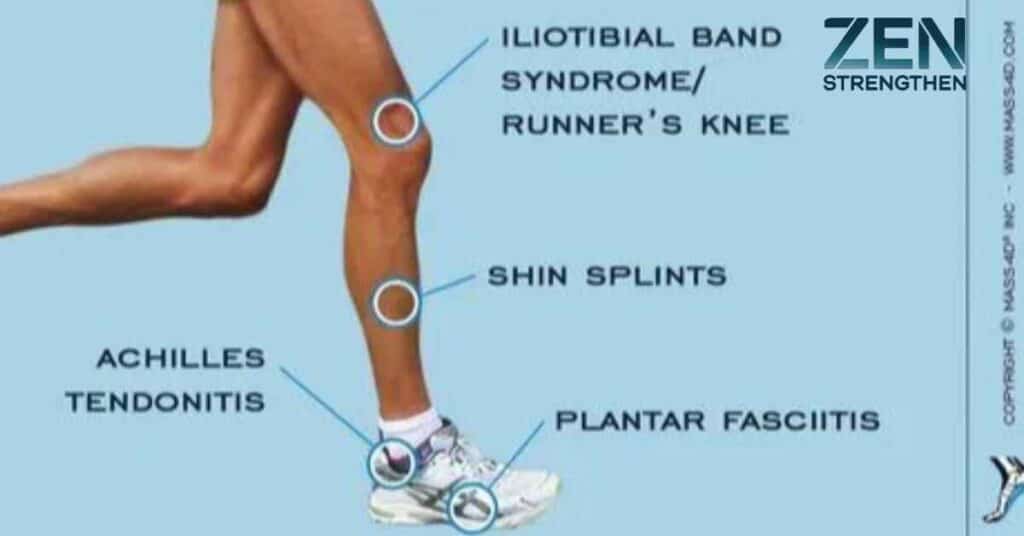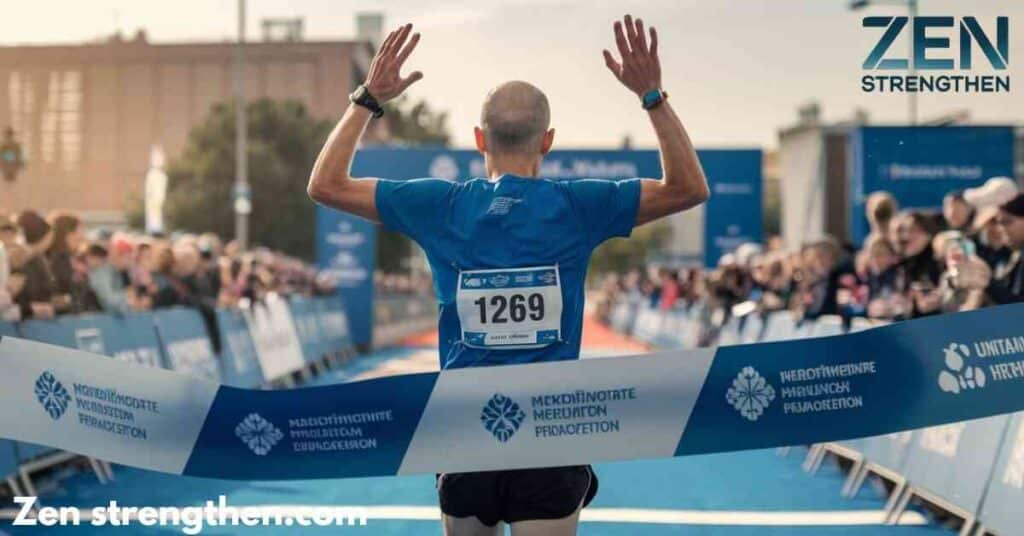Ever wondered how many steps it takes to complete a marathon? On average, it’s about 40,000 steps to conquer 26.2 miles! This impressive number might seem daunting, but each step symbolizes progress. Many runners break the distance into smaller goals, making it easier to tackle.
Whether you’re an experienced marathoner or a beginner, knowing your step count helps with training. Start with achievable milestones and gradually increase your distance. Tracking your steps motivates you and highlights your progress.
Marathon Distance Mechanics

The journey of completing a marathon involves far more than just putting one foot in front of the other. Whether you’re walking or running, understanding the mechanics of each step can dramatically improve your performance and experience.
Breaking Down the Numbers
A standard marathon spans 26.2 miles (42.195 kilometers), requiring between 41,000 and 60,000 steps depending on your approach. Here’s how the numbers break down:
| Activity Level | Average Steps | Time Range | Typical Pace |
| Elite Runners | 41,000-45,000 | 2:00-2:30 | 4:30-5:00/mile |
| Regular Runners | 45,000-50,000 | 3:00-4:00 | 6:30-8:00/mile |
| Run/Walk Method | 50,000-55,000 | 4:00-5:00 | 9:00-11:00/mile |
| Power Walking | 55,000-60,000 | 5:00-6:30 | 12:00-15:00/mile |
Scientific Analysis of Marathon Steps
Biomechanical Factors
Several key factors influence your step count during a marathon:
- Stride Length
- Average male stride: 30-32 inches
- Average female stride: 26-28 inches
- Influenced by height, flexibility, and training
- Cadence (Steps per Minute)
- Optimal running cadence: 170-180 steps/minute
- Walking cadence: 130-140 steps/minute
- Power walking cadence: 140-150 steps/minute
Impact of Training on Step Efficiency
Base mileage development affects step efficiency:
- Beginners: Focus on building endurance
- Intermediate: Enhance stride efficiency
- Advanced: Optimize energy conservation
“The key to marathon success isn’t just in the steps you take, but in how efficiently you take them.” – Coach Mark Williams, Olympic Marathon Trainer
Training Requirements and Preparation

Building Your Base
A proper training schedule typically spans 16-20 weeks:
- Foundation Phase (Weeks 1-4)
- Build base mileage
- Focus on proper form
- Gradually increase distance
- Development Phase (Weeks 5-12)
- Increase weekly mileage
- Introduce speed work
- Long runs up to 18-20 miles
- Peak Phase (Weeks 13-16)
- Maximum mileage weeks
- Race-specific training
- Tapering period
Essential Gear and Equipment
Proper walking shoes and equipment are crucial:
| Item Type | Purpose | Replacement Frequency |
| Training Shoes | Daily workouts | Every 400-500 miles |
| Race Day Shoes | Marathon event | Every 300-400 miles |
| Moisture-Wicking Gear | Temperature regulation | Every 6-12 months |
| Support Accessories | Injury prevention | As needed |
Race Day Strategy and Execution
Pacing Strategy
Successful marathoners follow strategic pacing:
- First 10 miles:
- Maintain conservative pace
- Focus on form
- Regular hydration
- Miles 10-20:
- Steady effort
- Mental focus
- Nutrition implementation
- Final 6.2 miles:
- Adjust pace as needed
- Utilize mental strategies
- Push through fatigue
Nutrition and Hydration
Fuel your marathon training properly:
- Pre-race:
- Carbohydrate loading
- Hydration strategy
- Electrolyte balance
- During race:
- Energy gels every 45-60 minutes
- Water at every station
- Salt tablets as needed
Injury Prevention and Management

Common Issues and Solutions
To prevent common injuries, consider:
- Training Phase Prevention:
- Proper warm-up routines
- Regular stretching
- Strength training
- Race Day Prevention:
- Anti-chafing strategies
- Proper hydration
- Pace management
Recovery Protocols
Post-marathon recovery essentials:
| Timeline | Action | Purpose |
| Immediate | Light walking | Prevent stiffness |
| 24-48 hours | Active recovery | Promote healing |
| 1 week | Light exercise | Return to activity |
| 2-3 weeks | Regular training | Resume routine |
Technology and Tracking
Modern Training Tools
Essential tech for marathon preparation:
- GPS Watches
- Pace monitoring
- Distance tracking
- Heart rate data
- Mobile Apps
- Training logs
- Route planning
- Performance analysis
Data Analysis
Key metrics to track:
- Step count
- Heart rate zones
- Pace variations
- Energy expenditure
Community and Support
Finding Your crew
Join the marathon community through:
- Local running clubs
- Online forums
- Training groups
- Virtual challenges
Expert Support
Seek guidance from:
- Certified coaches
- Physical therapists
- Nutritionists
- Experienced marathoners
“Remember,” every marathon begins with that first step, and every runner moves at their own pace. So lace up your shoes and embrace the journey. With commitment and practice, you’ll discover not only how many steps it takes to complete a marathon but also the joy of every step along the way!
some Facts
Completing a marathon requires understanding and implementing multiple factors:
- Proper training progression
- Adequate gear and preparation
- Effective pacing strategy
- Nutrition and hydration plan
- Injury prevention methods
Success comes from combining these elements with dedication and consistent effort. Remember, every marathoner starts with a single step – it’s how you manage the thousands that follow that determines your success.
“The marathon is not really about the marathon, it’s about the shared struggle.” – Bill Rogers, Four-time Boston Marathon winner
Advanced Training Techniques
Specialized Training Methods
Incorporating diverse training approaches enhances marathon preparation:
- Long-Distance Walking Sessions
- Weekend long walks (20-22 miles)
- Progressive distance building
- Recovery techniques
- Mental endurance practice
- Cross-Training Activities
- Swimming: Low-impact endurance
- Cycling: Cardiovascular strength
- Yoga: Flexibility and balance
- Strength training: Muscle endurance
Heart Rate Zone Training
| Zone | Percentage of Max HR | Training Benefit |
| Zone 1 (50-60%) | Recovery | Active rest, warmup |
| Zone 2 (60-70%) | Base building | Endurance foundation |
| Zone 3 (70-80%) | Aerobic | Improved efficiency |
| Zone 4 (80-90%) | Threshold | Race pace practice |
| Zone 5 (90-100%) | Maximum | Speed development |
Nutrition Deep Dive
Pre-Marathon Nutrition Strategy
To effectively fuel your marathon training, follow this timeline:
Week Before:
markdown
Copy
– Increase complex carbohydrates
– Maintain hydration levels
– Reduce fiber intake
– Monitor protein consumption
Day Before:
- Breakfast: Complex carbs, moderate protein
- Lunch: Light, easily digestible meals
- Dinner: Carb-loading, low fat
Race Day Nutrition
| Timing | Food/Drink | Amount | Purpose |
| 3 hrs before | Oatmeal/banana | 300-400 cal | Energy stores |
| 1 hr before | Sports drink | 8-12 oz | Hydration |
| Every 45 min | Energy gel | 100 cal | Sustained energy |
| Every 15 min | Water/electrolytes | 4-6 oz | Hydration maintenance |
Gear and Equipment Deep Dive

Essential Walking Shoes Features
Modern marathon gear requirements:
- Primary Features:
- Breathable mesh upper
- Cushioned midsole
- Flexible sole design
- Heel support system
- Sweat-Wicking Clothing Requirements:
- Moisture management
- Temperature regulation
- Chafing prevention
- UV protection
Seasonal Gear Adjustments
| Season | Key Equipment | Special Considerations |
| Summer | Light, breathable gear | Sun protection, extra hydration |
| Winter | Layered clothing | Wind protection, visibility |
| Spring | Versatile pieces | Weather adaptability |
| Fall | Medium weight gear | Temperature variation |
Race Strategy Optimization
Pacing by Course Type
Different courses require unique approaches:
- Flat Courses
- Consistent pace
- Regular stride length
- Focus on efficiency
- Hilly Courses
- Effort-based pacing
- Modified stride length
- Strategic energy conservation
Mental Strategies
Key psychological approaches:
- Segmentation technique
- Positive self-talk
- Visualization methods
- Goal-setting strategies
Recovery and Post-Marathon Care
Immediate Recovery Protocol
First 24 Hours:
markdown
Copy
1. Light walking (15-20 minutes)
2. Hydration restoration
3. Protein-rich nutrition
4. Compression gear usage
Long-Term Recovery Plan
| Timeline | Activity Level | Focus Areas |
| Days 1-3 | Very light | Active recovery |
| Days 4-7 | Light | Flexibility work |
| Week 2 | Moderate | Return to activity |
| Week 3-4 | Progressive | Training resumption |
Setting Future Goals
Post-Marathon Planning
- Recovery period goals
- Next event selection
- Training modification
- Performance analysis
Performance Improvement Strategy
Create a structured approach:
- Analyze race data
- Identify weaknesses
- Set specific targets
- Develop action plans
Community Engagement
Finding Support Networks
Join marathon communities through:
- Local Clubs
- Training partners
- Shared experiences
- Expert guidance
- Online Resources
- Virtual communities
- Training apps
- Social platforms
Giving Back
Contribute to the community:
- Mentor new runners
- Share experiences
- Volunteer at events
- Support local races
Conclusion
Success in marathon completion combines:
- Proper physical preparation
- Mental readiness
- Equipment optimization
- Community support
- Strategic execution
Remember these key points:
- Consistent training yields results
- Proper gear prevents injuries
- Community support enhances experience
- Recovery is crucial for longevity
“Every marathoner has two races: the one against the distance and the one against themselves.” – Elite Coach David Thompson
This comprehensive guide provides the foundation for successful marathon completion, whether walking or running. Focus on consistent preparation, proper gear selection, and strategic execution to achieve your marathon goals.
FAQ,s
How many steps does it take to complete a marathon?
The number of steps to complete a marathon varies by person, but on average, it takes about 40,000 to 50,000 steps.
Why does the number of steps vary between runners?
Different factors like height, stride length, and running style affect the total steps. Taller runners usually take fewer steps than shorter runners.
How can I estimate my own steps for a marathon?
You can estimate your steps by tracking your average stride length. Multiply your stride length by the total distance of the marathon (26.2 miles).
What is the average stride length for runners?
The average stride length for most runners is about 3 to 5 feet. This can change based on speed and fitness level.
Does terrain affect the number of steps?
Yes, running on hills or uneven surfaces may change your stride length and increase the total number of steps.
Can I reduce the number of steps I take?
Improving your running form and training can help you run more efficiently, potentially reducing your total steps.
Disclaimer
“This article ” is intended for general informational purposes only and does not address individual circumstances. It is not a substitute for professional advice or help and should not be relied on to make decisions of any kind. Any action you take upon the information presented in this article is strictly at your own risk and responsibility!

Jhon Wick is a seasoned writer in the fitness niche, dedicated to sharing expert advice and the latest trends. With a passion for health and wellness, Jhon offers practical tips and inspiration to help readers achieve their fitness goals and stay motivated.







